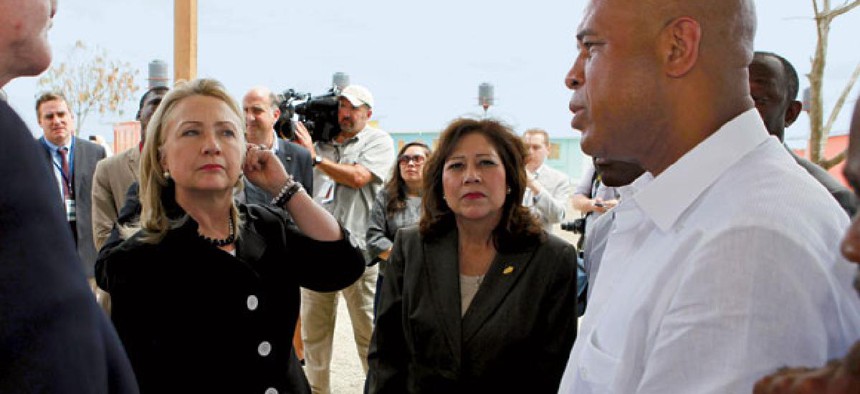
In their former Cabinet roles, Hillary Clinton (left) and Hilda Solis met with Haitian President Michel Martelly. Larry Downing/AP
Rising to the Top
Five things successful women in government do.
When it comes to women’s achievements, few compare to their rise in government. In President Obama’s first term Cabinet, five women were selected to provide the president key insight into running government. Although the path to gender parity in government leadership positions is slow, women continue to make strides.
In January, however, there was an exodus of high-profile female members of Obama’s Cabinet, including Secretary of State Hillary Clinton, Environmental Protection Agency Administrator Lisa Jackson, Labor Secretary Hilda Solis and Deputy Chief of Staff Nancy-Ann DeParle. The president recently tapped clean air regulator Gina McCarthy to lead EPA and REI chief executive Sally Jewell to be Interior secretary. And White House press secretary Jay Carney has asked citizens to reserve judgment until more appointments are made.
With judgment reserved, one can’t help but wonder about women’s role in federal leadership. Often, high-
performing officials are plucked from agencies to fill second term appointments. According to the Bureau of Labor Statistics, women make up 44 percent of the federal workforce, almost an equal playing field with men in competition for these positions. Yet the gap persists.
Education is not the reason. On average, working women tend to be more educated than men. In 1970, 22 percent of women in the labor force had either attended some college or graduated with a degree. By 2010, 67 percent of women had at least some college education.
The much-maligned old boys’ network might be part of the problem—and the solution. The network establishes relationships on the golf course and other places outside the office. It fosters relationship-building for the sake of business and joins mentors with willing professional novices.
Therein lies the opportunity. In government and the corporate world alike, people who rise to top leadership positions don’t get there with only a laundry list of accomplishments. They ride there by taking initiative and leveraging the help of their networks. Building a network, however, is more than just exchanging business cards. Here are five things successful women do to rise to the top:
- Just ask. A killer performance on that last small project is a great start in getting your name out there. But being known for organizing the filing cabinet or taking charge of the timelines won’t get you the exposure you need. One commonly cited impediment to female leadership growth is lack of exposure on high-profile projects. If there is a big project that you want to be part of, make a case for your contribution. It is likely you will be welcomed with open arms.
- Find a mentor. Unlike private companies, agencies often don’t have official mentoring programs. When trying to identify a mentor, think of those who have given you good advice and who work outside your department. The next time they give you a tip, ask whether you can call on them for their insight. This begins a less formal process for building relationships and growing in your role.
- Be your own advocate. Nobody knows your contribution more than you do. People are busy, and not all of your successes are known departmentwide. Forget any hesitation about sounding selfish if you tout one of your achievements. Step up to the plate and make sure your role in the last successful project is known.
- Network with other women. In the workplace, female leaders beget more female leaders. As more women break down the lingering cultural and institutional barriers to leadership, it paves the way for mentorships and opportunities for others. Events and conferences also provide enormous opportunities for women to make professional connections.
- Be supportive. One common stereotype is that women compete more fiercely with women for top positions. Not only is this anecdotal at best, but harmful if propagated. At a recent event hosted by Government Executive, I presented research I conducted for the Government Business Council and was overwhelmed with constructive feedback—especially from women. Support all your colleagues when you can; professional karma isn’t the stuff of myths.
NEXT STORY: Bringing Leaders Up to Speed







